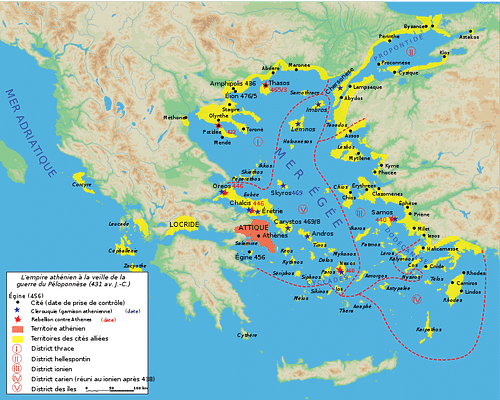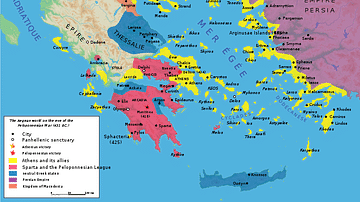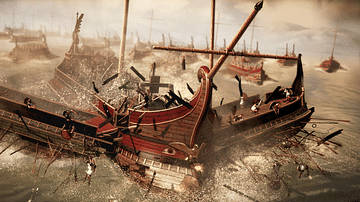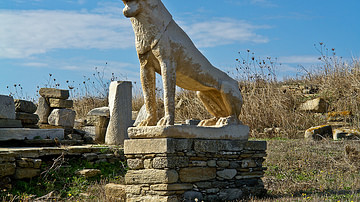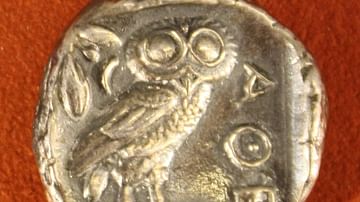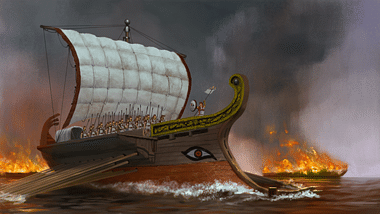
Cimon (c. 510 – 450 BCE) was an Athenian statesman and, as strategos, frequent commander of the Athenian fleet when the city was at the height of its power. He won military glory by defeating Spartan rival Pausanias and then the Persians in both a land and sea battle to expand the membership and power of the Delian League which he led for over a decade. Not helped by his political rival Pericles, Cimon was later exiled from Athens and never recovered his former political position but he had already done enough to establish a lasting reputation as one of Athens' greatest generals. He is the subject of one of Plutarch's Lives biographies.
Early Life
Born around 510 BCE Cimon (also spelt Kimon) was the son of the general and statesman Miltiades who had famously defeated the Persians at the Battle of Marathon in 490 BCE. His mother Hegesipyle, as the daughter of Olorus, king of Thrace, was also well-to-do. Cimon's sister was Elpinice and there were accusations, now supported by some archaeological evidence, of incest between the two, even if she was married to Callias, the prominent politician. Cimon married Isodice of the Athenian aristocratic Alcmaeonid family so that with powerful family connections he was set to rise to the very top of Athens' political pile.
Military Achievements
Cimon fought at the Battle of Salamis in 480 BCE but first comes to political prominence in 479 BCE when he was part of a delegation sent to Sparta. In the following years he was influential in persuading Greek naval powers to join the Delian League, and between 476 and 463 BCE he was frequently made strategos or commanding general of the Athenian fleet and the League as a whole. Amongst his notable victories, he drove the Dolopian pirates out of the Aegean island of Scyros c. 475 BCE. In so doing he won glory by bringing back to Athens the fabled bones of Athens' legendary king Theseus and then made the island an Athenian dependency.
In another successful operation the Spartan general Pausanias was defeated and removed from Byzantium, also c. 475 BCE. Eion in Thrace was another capture for Athens in the same year. There the citizens were enslaved and Cimon set up three Hermes statues in Athens to commemorate the victory. Cimon's star shone even brighter c. 466 when he defeated the Persians at Eurymedon on the southern coast of Asia Minor, twice on the same day in fact, first in a naval engagement and then on land, both times against superior forces. Cimon is credited with improving the effectiveness of the Greek trireme warship by broadening its decks and gangways to allow the transport of more hoplites. In another episode of inventiveness, the general had also had some of his men disguise themselves as Persians using captured clothing to raid an enemy camp. Victory permitted the annexing of more allies to further bolster the Delian League and Cimon's own reputation as one of Athens' greatest commanders.
Cimon also did much for the ordinary citizens of the city too. He rebuilt many public spaces, improved the southern walls of the acropolis, added a water supply to the Academy and trees to the agora and Academy gymnasium, gave the needy handouts, and personally funded a programme to strengthen the Long Walls fortifications which connected Athens to her port, the Piraeus.
Following victory over the Persians, some historians suggest that Cimon offered to broker a peace deal with Athens' long-time regional rival but that opposing factions in Athens blocked it. The Peace of Callias, c. 450 BCE (proposed by Cimon's brother-in-law), may have been a re-working or even extension of Cimon's original plan. Cimon might have been finished with his old family enemy Persia but he was not done with military expansion and conquered Chersonesus in Thrace and the north-Aegean island of Thasos (along with her gold mines) between 465 and 463 BCE. According to Plutarch the proposal for members of the expanding Delian League, fast becoming the Athenian empire, to pay Athens money instead of ships and men was Cimon's.
Rivalry with Pericles & Exile
Cimon's political career then took a blow in 463 BCE when Pericles formally charged him with corruption. Specifically, he was accused of taking bribes from Alexander I King of Macedon so as not to invade. Acquitted, Cimon was then sent to aid Sparta deal with their helot revolt. The Spartans sent the commander's hoplite army back home, though, afraid of their intentions. As a consequence, in 461 BCE, Cimon, who was always thought to have held Spartan sympathies, suffered a vote of ostracism and was exiled from Athens for 10 years. The commander's reputation for lavish parties and expensive public works had not been helpful in turning public opinion either.
In 457 BCE Cimon did offer his services at Tanagra against a joint force of Sparta and Boeotians but was refused; Athens lost the battle. When he had served his 10-year sentence, Cimon did finally return to his home city and he brokered a peace with Sparta. Then, still fighting Persians until the end, he died either in battle or from disease on Cyprus in 450 BCE. As Plutarch summarized, "He was as brave as Miltiades and as intelligent as Themistocles, and he is generally admitted to have been a juster man than either (Cimon, 146)."
